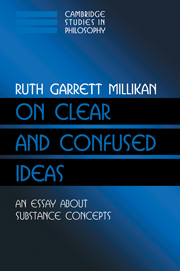Book contents
- Frontmatter
- Contents
- Preface
- Chapter 1 Introducing Substance Concepts
- Chapter 2 Substances: The Ontology
- Chapter 3 Classifying, Identifying, and the Function of Substance Concepts
- Chapter 4 The Nature of Abilities: How Is Extension Determined?
- Chapter 5 More Mama, More Milk and More Mouse: The Structure and Development of Substance Concepts
- Chapter 6 Substance Concepts Through Language: Knowing the Meanings of Words
- Chapter 7 How We Make Our Ideas Clear: Epistemology for Empirical Concepts
- Chapter 8 Content and Vehicle in Perception
- Chapter 9 Sames Versus Sameness in Conceptual Contents and Vehicles
- Chapter 10 Grasping Sameness
- Chapter 11 In Search of Strawsonian Modes of Presentation
- Chapter 12 Rejecting Identity Judgments and Fregean Modes
- Chapter 13 Knowing What I'm Thinking Of
- Chapter 14 How Extensions of New Substance Concepts are Fixed: How Substance Concepts Acquire Intentionality
- Chapter 15 Cognitive Luck: Substance Concepts in an Evolutionary Frame
- Appendix A Contrast with Evans on Information-Based Thoughts
- Appendix B What Has Natural Information to Do with Intentional Representation?
- References
- Index
Chapter 9 - Sames Versus Sameness in Conceptual Contents and Vehicles
Published online by Cambridge University Press: 02 December 2009
- Frontmatter
- Contents
- Preface
- Chapter 1 Introducing Substance Concepts
- Chapter 2 Substances: The Ontology
- Chapter 3 Classifying, Identifying, and the Function of Substance Concepts
- Chapter 4 The Nature of Abilities: How Is Extension Determined?
- Chapter 5 More Mama, More Milk and More Mouse: The Structure and Development of Substance Concepts
- Chapter 6 Substance Concepts Through Language: Knowing the Meanings of Words
- Chapter 7 How We Make Our Ideas Clear: Epistemology for Empirical Concepts
- Chapter 8 Content and Vehicle in Perception
- Chapter 9 Sames Versus Sameness in Conceptual Contents and Vehicles
- Chapter 10 Grasping Sameness
- Chapter 11 In Search of Strawsonian Modes of Presentation
- Chapter 12 Rejecting Identity Judgments and Fregean Modes
- Chapter 13 Knowing What I'm Thinking Of
- Chapter 14 How Extensions of New Substance Concepts are Fixed: How Substance Concepts Acquire Intentionality
- Chapter 15 Cognitive Luck: Substance Concepts in an Evolutionary Frame
- Appendix A Contrast with Evans on Information-Based Thoughts
- Appendix B What Has Natural Information to Do with Intentional Representation?
- References
- Index
Summary
SAMES, DIFFERENTS, SAME, AND DIFFERENT
For certain purposes sameness can be treated as a relation. So treated it is of special interest because, although there is only one kind of real sameness relation, hence only one kind of sameness in the real world, and only one kind of sameness on the level of intermediaries (intermediaries are, after all, supposed to be real in their own realm) there are two separate relations corresponding to sameness on the level of intentional content. A visaging might involve (1) two or more presentations of what is the same content in fact or (2) two or more presented contents visaged as being the same. Call the first of these a “visaging of sames,” the second a “visaging of sameness.” Either can occur without the other – as I will slowly try to make clear – or they can occur together. Compare other internal relations. One might visage a tone, say, middle C, and also visage a different tone, say, A above C, but not visage one being a fifth higher than the other though of course it is. Or one might visage that one color was brighter than another without visaging either of these as a definite brightness or even as very definite hues. Imagine, for example, that the lighting is poor and peculiar, so one can't really tell “what the colors are.” The passive picture theory of perception (Section 8.2), however, with its projection of properties of the visaged onto the intermediaries of the visaging, requires that visaged sameness should correspond to real sameness in intermediaries, that is, that sameness should be represented by sameness.
- Type
- Chapter
- Information
- On Clear and Confused IdeasAn Essay about Substance Concepts, pp. 123 - 135Publisher: Cambridge University PressPrint publication year: 2000



